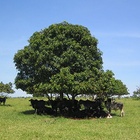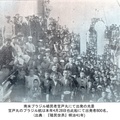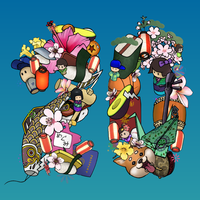There are people who are called "immigrant fathers" among the 100-year history of Japanese immigrants to Brazil. I have never heard of a father of immigrants to Hawaii or Peru, so Japanese immigrants to Brazil may be the only ones who have "fathers."
Indeed, in a place as far away as Brazil, nothing can get done unless someone takes the initiative to prepare a place to receive the migrants and procure ships, in other words, to start a business, so there is room for "fathers" to be born in such a place.
The man who carried out this series of projects and became known as the "father of immigration" was a man named Mizuno Ryu.
The first group of about 800 Japanese immigrants to Brazil, the fathers of immigration and their "children," so to speak, set off for Brazil on April 27, 1908, on a ship called the Kasato Maru. The journal that Mizuno kept during the voyage is kept in a historical museum in a town inland of São Paulo State. It is a small, thin notebook that fits in the palm of your hand, but the writing on the cover has faded and is no longer legible.
As a curator at the museum, I have been slowly researching Mizuno Ryu, the owner of this notebook, and recently I met Mizuno Ryu's son, RZ. He is not just a figurative "child," but his genuine, biological son. Although I was close enough to visit him that I could have easily done so if I had wanted to, I never had the chance because I assumed that Mizuno Ryu's son, who was born at the end of the Edo period, could not possibly still be alive. I never even thought about trying to find him.
"I was my father's son when he was 75 years old. I'm 77 now," he said.
The term "father of immigration" is, of course, full of respect, but perhaps because Japanese immigrants to Brazil faced many hardships, Ryu Mizuno's reputation is not all good. Some even say it is laughable to call Ryu Mizuno the father of immigration.
During the first round, people were more commonly referred to as "emigrants" than "emigrants." Most people went to Brazil to make quick money, and few had any intention of settling there.
However, when they actually arrived, the situation was far from one in which they could make a fortune in a short time and return home in glory. Many of the immigrants who arrived on the Kasato Maru and were sent to work as contract laborers on coffee plantations in the state of São Paulo ended up causing trouble or deserting. "That's not what we said."
The story certainly differed from what was advertised beforehand. There were some parts that could be called unavoidable that led to the situation, and Mizuno, the president of the immigration company, was also to blame. At the time, immigration companies were known to do some pretty shady things, so it's not surprising that some people felt that Mizuno had deceived them. I heard that some of the Kasato Maru immigrants who died in Brazil unable to return home because they had not made any profit harbored a grudge against Mizuno to the very end.
Mizuno never gave up on the Brazilian immigration project until his death, and gradually got it back on track, but the first Japanese immigration to Brazil, the Kasato Maru, is remembered as a "tragedy" in the history of Japanese immigration to Brazil. Mizuno is cast as more of a villain in that story.
However, there were also people who appreciated Mizuno's work. The war broke out during a temporary return to Japan, and Mizuno ended up being separated from his family for nearly 10 years. In his final years, however, it was volunteers from other Brazilian immigrant groups who raised the funds to help him return to Brazil. It was probably this group that first began calling him the "father of immigration."
If you think about it, fathers are not necessarily people to be respected. It is not uncommon for fathers to be the object of hatred, and some people grow up to be adults through a relationship with such a father. In that sense, it may be a good idea to think of Mizuno as the "father of immigration." There is no need for a hero at the origin of history. In any case, the Japanese community in Brazil is currently the largest in the world, and although they are an ethnic minority, they have a strong presence in the Brazilian nation.
So, what kind of person was his father, Ryu Mizuno, in the real relationship with his son? According to RZ, who spent his childhood in the "colony" that Ryu Mizuno, who resolved to settle in Brazil as an immigrant at the age of 80, developed, their relationship seems to have been quite complicated.
A father who devoted himself almost entirely to the immigration business, and a mother who struggled under its influence. From the way RZ talked, we could see that in his youth, he always saw things from his mother's side, and was always sympathetic to her. However, his father's presence was not small. This was also evident from the fact that he remembered every word and action of his father in minute detail.
During his adolescence, he lived apart in Japan and Brazil, and when he was reunited with his father, he only spent two weeks with him. This may have been because Ryu Mizuno passed away about a year after returning to Brazil, but I think he may not have been able to be so happy about the reunion when he thought about the hardships his family endured during his father's absence.
When he grew up, RZ started his own business and was very successful for a time, but then he was betrayed by his colleagues and things started to go wrong. He felt that the way he was deceived showed a commonality between his own personality and his father's. Then, at the age of 77, he looked back and realized that he had somehow lived his life with the same values as his father.
Of course, RZ's father remains an important figure to him today, and he is happy that he is once again being put in the spotlight to mark the 100th anniversary of immigration.
© 2008 Shigeo Nakamura










